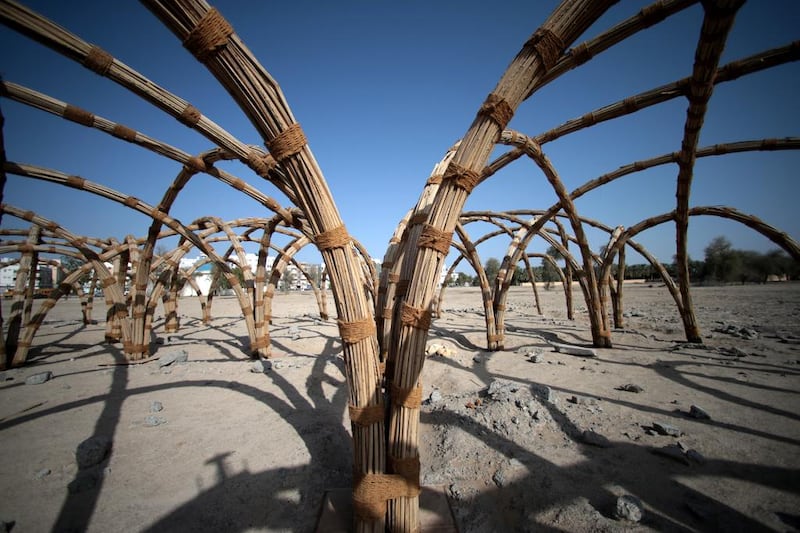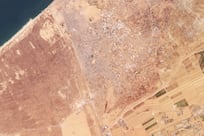The date palm remains as emblematic of the Gulf region today as it ever was in the past.
With hundreds lining major roads, and with their tasty dates a favourite purchase in local supermarkets, life here would be a little less appealing without them.
What is more, the benefits they bring extend beyond satisfying our palates and beautifying local cityscapes.
As reported last year, researchers at Masdar Institute of Science and Technology were looking at ways of turning date palm waste into charcoal-like biochar, which improves fertility and water retention in soil.
Biochar has also been credited with preventing pests and diseases from spreading.
The UAE has about 40 million date palms, each generating about 15 kilograms of waste biomass annually, so there is no shortage of material.
Separately, the defence company AgustaWestland is exploring applications for date palm waste. It is considering burning it to produce electricity and heat for industrial use, turning it into compost, creating building insulation and improving the capabilities of construction material.
Date palm waste has a high lignin content and can also be digested by yeast to produce valuable pharmaceuticals and industrial products. The Anglo-Italian company aims to develop a commercially viable scheme involving local farmers who can guarantee a supply of date palm material to justify the investment.
“Local people recognise this material is being discarded and they cannot help feeling they should be doing something beneficial with it,” said David Francis, the company’s industry participation manager.
To help determine the productive uses to which it could be put to, the firm has collected date palm waste from farms in Al Ain, Liwa and Ras Al Khaimah, and sent it around the world for analysis.
“Hopefully, later this year, we’ll be able to go back to the farmers and say to them, ‘this is what we think we can do’,” said Mr Francis, noting that a scheme could have “huge potential for the UAE to pioneer new technologies and develop the knowledge and experience required to generate sustainable exports”.
Applications for palm material in building are another interest to the UAE.
The Sabla Project in Al Ain, for example, is investigating how palm fronds, bundled together with rope, can create the structure of a building.
“People have used plant material in the past but they’ve always used it without knowing the capability of it,” said Dr Sunday Popo-Ola, a research and teaching fellow at the department of civil and environmental engineering at Imperial College London, who is associated with the initiative.
“Bamboo has been used widely in South America and some parts of Africa. They don’t have a clue how strong these are.”
There is also research into how fibres from date palms, bamboo and other plants can improve the properties of substances such as concrete. Concrete can lack tensile strength so often steel or plastic are incorporated to increase its durability, and natural fibres can play a similar role.
“Concrete is not very good in tension. It cracks very easily,” said Dr Popo-Ola. “Putting these fibres in binds it together.”
A 2012 paper in the International Journal of Physical Sciences, Performance of Date Palm Fibres-reinforced Plaster Concrete, found that the fibres made concrete easier to deform and manipulate, less likely to crack and a better insulator.
“The advantage of using palm natural fibres is that it is an environmentally friendly material. Maybe some man-made fibres result in a better lifespan for the concrete product, but its production is harmful to the environment,” said Dr Hadi Abou Chakra of Beirut Arab University’s department of industrial engineering and engineering management.
Dr Chakra and other researchers from his university last year published a paper in the European Scientific Journal on using fibres from the leaves of the fan palm in concrete. They described a method that involved pre-treating them with a sodium hydroxide or caustic soda solution before mixing with concrete.
The alkali solution roughened the fibres’ surface, helping them to form stronger bonds with the concrete. It also improved the fibres’ tensile strength and elasticity, and is thought likely to improve their durability, which is important because under normal conditions, natural fibres in concrete can weaken over time.
Similarly, last year in the International Journal of Sustainable Built Environment, researchers in Qatar described a pre-treatment regime using calcium hydroxide for fibres from the leaves of female date palms.
Despite the research, there are few cases where natural fibres have been used in concrete for structural purposes, according to Prof Erik Schlangen of Delft University of Technology in The Netherlands, who studies the use of natural fibres from, for example, hardwoods, softwoods, banana plants and bamboo, in concrete.
“A lot of people are investigating it, if it really works, and if durability is OK, but real applications on a structural level are not that many. It’s usually for reinforcement for cladding elements but not for structural elements.”
Although chemical pre-treatments are being developed, the technology, he said, was not as eco-friendly as envisaged.
“They do have a future but we need to work out more the real durability aspects.”
So ultimately, as well as providing succulent fruit, being used in landscape gardening and helping to improve soil fertility, date palms could become important in the construction of buildings, or at least in producing non-structural elements such as concrete barriers, pavement slabs and tiles.
In terms of what the date palm can be used for, it seems, more than 5,000 years on from when the trees were first cultivated, we have only scratched the surface.
newsdesk@thenational.ae






